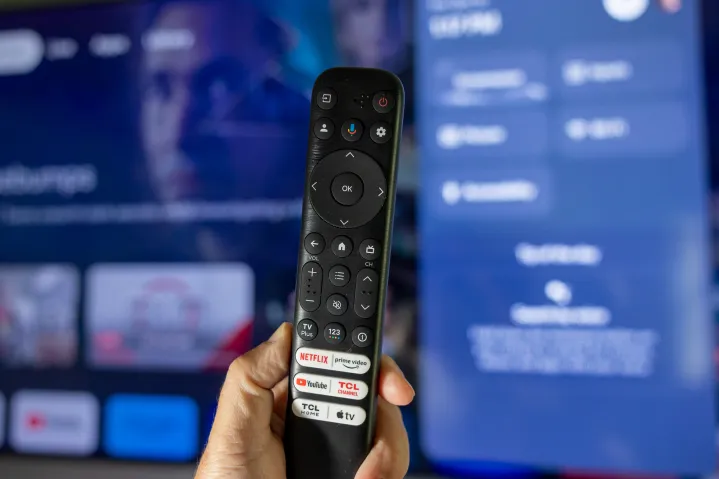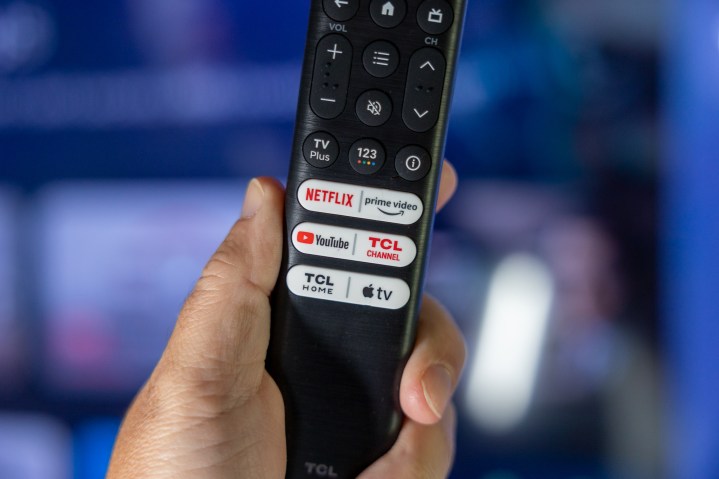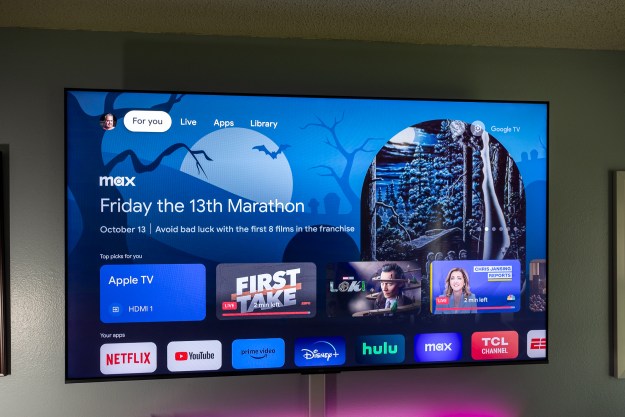
“The TCL Q6 2023 is one of those TVs in which you get what you paid for.”
- Great value
- Google TV built-in
- Easy to use
- Decent remote control
- Panel quality matches the price
- Remote not backlit
- Bloatware in the operating system
This isn’t going to be the usual sort of Digital Trends TV review. For a few reasons, really. First is that I’m not Caleb Denison. I’m Phil Nickinson. I’ve got more beard on the front. Less hair on the top. And I’m nowhere near the panels expert that he is.
And this TCL television — the 75Q650G, to be precise — isn’t a top-shelf TV. If you didn’t suss it out from the model number, we’re talking about a TCL Q6 OLED TV here, which is at the lowest rung of the Q series (the other models are the Q7 and QM8.)
We’ve had a good bit to say about the Q7 and QM8. In our Q7 QLED TV review, Caleb basically ranked it as a pretty good buy for most folks, but a letdown for enthusiasts trying to get by on a budget. In his TCL QM8 review, Caleb crows of that set being “my go-to TV recommendation for probably 90% of people this year.” Fair enough.
The TCL Q6 is the sort of TV the “average” consumer will pick up. And, hey! That’s me! (More or less.) So this review is going to be more pass/fail than A through F. I’m not going to go super nerdy on specs and measurements. That’s Caleb’s thing. (And he can keep it!) Instead, I’m going to talk about what I like and what I don’t like in this sort of TV that I’d put in a spare room — or even in my bedroom, which is where it’s ended up.
Series and size details
Caleb always does this part, and I shall, too. I’m reviewing the 75-inch model, and what I experience should ring true for the larger and smaller options as well.
| Screen Size | Model Number | Price |
| 55-inch | 55Q650G | $400 |
| 65-inch | 65Q650G | $500 |
| 75-inch | 75Q650G | $750 |
| 85-inch | 85Q650G | $1,200 |
TCL Q6: setting the stage
Let’s look at the TCL Q6 a little more in context of the Q series. Like the Q7, we’re looking at an LED backlit LCD panel and not mini-LED like what’s on the QM8. We’ve got a full explainer on the differences between LED versus mini-LED QLED TVs, so I won’t go into that here except to say that mini-LED can sometimes provide better blacks, less light bleed, and more accurate color, which is why it’s in the higher-end (and more expensive) line.
And you can effectively look at the Q6 options like they’re half the price of the Q7 lineup. I tend to believe that price is the No. 1 driving force for non-nerds when it comes to buying a new TV, so that’s a good enough place to start.

With all due respect to the folks who do them, I find unboxings boring. They’re either mostly painless — or a complete nightmare. TCL has kept the Q6 in the former category. The remote control, feet, manual and other bits and pieces are all easily found amid the styrofoam and cardboard, and the TV was easy to unpack without breaking too much of the packaging. (That’s important in case you end up with a dead panel that has to be returned. It happens.)
This Q6 was replacing a 65-inch 2018 TCL 6-Series Roku TV in my bedroom. And, more specifically, it was going on the wall.
A quick word on that: I can’t recommend mounting a television on the wall enough, particularly if it’s way bigger than what your spouse expected you to bring home. It’ll make the room look that much bigger. Take the time to do it. And if you’re scared about running wires through walls, just buy some cable concealers that you can also mount to the wall and call it a day. Nobody’s judging.
Anyway. All that’s to say that I quickly cast aside the plastic feet that come with the Q6. There’s nothing special here, though you do have the option to mount them wider, toward the outside edges of the TV, or inward, if you have a smaller stand. Use your best judgment there, though. I used the same wall-mount hardware I’ve had up for years — it was still good for a TV of this size — and that all went without a hitch.
TCL Q6: What it’s like to use
The Q6, like its brethren, is running the Google TV platform. It’s not quite exactly the same experience you’ll get if you plug a $50 Chromecast with Google TV into something, but it’s close enough for our purposes (though if you’re really looking to confuse your brain, you absolutely can plug one into the Q6).

Let’s talk a few specs before we get too much further. This is a 4K television, as you’d expect. And it’s got three HDMI ports, one of which serves as eARC, which is nice to see even at this end of the range. For HDR standards, it supports Dolby Vision, HDR10+, HDR10, and HLG. It’ll also play and pass through Dolby Atmos. The native panel refresh rate is 60Hz. That’s basically the bare minimum for anything you should buy in 2023. And for networking, it’s using Wi-Fi 5, aka 802.11ac. That should be more than fast enough to handle most streaming for most people. And there’s also Ethernet, if you want to plug in.
Setup is simple, and it’s a breath of fresh air for a smart TV to acknowledge that you might not actually want use it as a smart TV and instead just use it as a dumb display with something else plugged in. That’s what I opted for at first, actually, so that I could gauge it against what I’d been using previously, which was the 6-Series with an Apple TV 4K plugged in.
You’ll still have access to all the typical TV settings if you opt to go that route, and you’ll still see some Google and TCL options lurking about, even if you have no intention on ever using them. Again, kudos to TCL and/or Google for not making that a user-hostile experience.

Once I had everything set up as if I’d just replaced an older TV with a newer model — which essentially is what I’d done — I noticed a few things. First is that I still highly recommend putting an oversized television in the bedroom. It’s ridiculous, but also so much more affordable these days. Just do it. Second is that everything looked sort of … soft. Not necessarily bad — though you’ll definitely want to play around with the different picture modes and settings, as you should any on other TV in any other situation — just … a little softer. That’s probably just because my living room television is OLED, and so the difference in panel type really stands out here.
That said, I think I’ve convinced myself that a little bit of the backlight is bleeding through the edges of the panel. Maybe. If I’m looking for it. If, in fact, that’s what I’m seeing, it really doesn’t detract from the overall experience. Also, you’ll want to go into the picture settings and turn off the motion smoothing (a.k.a. the soap opera effect) because you are not an animal. (If you do like that sort of thing, I’m going to call you an animal and sleep just fine.)
After a couple weeks of use, I finally logged in with my Google credentials to test out the built-in apps and Google TV experience. And I basically found what I expected to find. It’s the basic Google TV experience on hardware that’s powerful enough to run it, and in a lot of instances, it actually managed to handle drawing the user interface better than I expected.

If you’re well-versed on Google TV and are way into the Google ecosystem, you’ll be right at home here. There functionally aren’t any real changes between what TCL has and what you’d find on a Google-built Chromecast (which I use all the time, too). There are some TCL tweaks to be found here — including TCL’s own free ad-supported television service called TCL tv+, and a whole separate smart-home scheme in TCL Home, for those who live fully inside the TCL ecosystem. There’s also other weirdness like TCL Safety Guard, which promises “Professional Protection for Superb Security.” It’s basically bloatware on a TV instead of a phone, and it’s a major reason why I’d prefer to use a TV as a dumb TV and instead opt to rely on other hardware for streaming.
In any event, the Q6 has been adequate to use with or without the built-in Google TV operating system. If you want to use Google TV, I’d just use what’s already installed here and not think twice. But if you want to use something else, go for it. TCL doesn’t stand in your way at all.
My not-as-discerning-as-Caleb eye didn’t have any real issues with colors. The 8K HDR YouTube video we like to run looked as good as ever. More interesting to me was whether it would appear consistent between the YouTube app in the built-in Google TV OS and the Apple TV 4K I usually have running. I was a little surprised to find that the Google TV instance didn’t kick in Dolby Vision and instead just showed “HDR” on the screen. Unless you’re running both side by side, however, you’d likely not even know. I was appreciative of the adjustments that could be made to white balance and saturation in the picture settings and once I tweaked those just a tad — not something I agonize over too much, really — things looked as good as I’d expect on a sub-$1,000 TV.
Brightness also wasn’t a concern at all. Of course, I was using a 75-inch TV in a modest master bedroom. Fun fact: The Nest Hub on my nightstand doesn’t realize all the lights in the room are off until I also turn off the television. It’s plenty bright for that use case.
Back to the price one more time: I’m no gamer. (That I actually lamented the loss of Google Stadia should show how infrequently I actually have a controller in my hand.) But it’s worth noting that while the native refresh rate is only 60Hz, The Q6 does has auto low latency mode and AMD FreeSync built in, and “Game Accelerator” for up to 120Hz variable refresh rates at 1080p resolution. Again, at less than $1,000 all but the biggest model.
The built-in 15-watt speakers aren’t bad. But, again, given the affordable price of the Q6, I’d consider spending what you’ve saved to get at least a basic soundbar. Even a simple one with a subwoofer will dramatically change your entire experience.


The remote control is nothing to write home about. It works fine. It feels fine. It’s long, made of light plastic, and has all the buttons you’d expect. The only detractions here are that it is not backlit (which maybe is only slightly surprising in a Q series TV) and there are no fewer than three TCL-branded buttons on board. One is for TV+ (but is labeled on the remote as TV Plus) and takes you to a guide of those free, ad-supported channels. Another button is for TCL Channel, which takes you to … another guide of those free, ad-supported channels (an August 2023 press release sort of explained the difference between the two, but not really). And there’s also a button for the previously mentioned TCL Home. That’s a lot of button real estate that probably could have been used for something else, but here we are, and I’m reminded yet again why I use an Apple TV 4K instead.
TCL Q6: The bottom line
After a couple of months of daily use, I can pretty clearly say the following: There is absolutely no shame in you — a normal TV-viewing person who doesn’t care all that much about refresh rates or local dimming zones or P3 Quad Deltas (I half made up that last spec) that are the sort of things we agonize over in high-end reviews — buying a Q6 and being perfectly happy with it.
Once I did my usual tweaking (which means killing any sort of motion control and fixing the white balance to my liking), I’ve not yet once said “this looks horrible.” In fact, it looks fine. It’s perfectly passable given that we’re talking about getting 65 inches for $500 and 75 inches for $250 more. The return you get on that investment in terms of sheer screen size, as well as having Google TV built-in, more than justifies the expenditure. Even if you don’t use all the extraneous TCL features and just go with what Google gives ya, that’s a superb deal.
And that’s before anyone starts talking sale prices.
My biggest concern here isn’t so much with the Q6 in particular, but with TVs like this in general: You should keep an eye on the software. The Q6 at the time of this writing (in October 2023) is built on Android 11 with a security patch from March 2023. If TCL doesn’t keep that relatively up to date, you might want to consider plugging in outside hardware.
Otherwise? Sit back, relax, and enjoy the view.
Editors’ Recommendations
Services Marketplace – Listings, Bookings & Reviews
